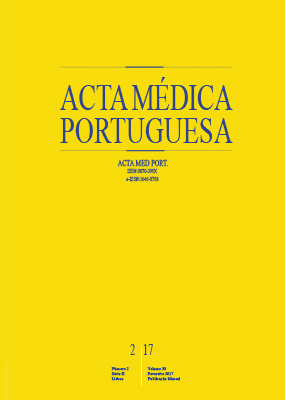The OXIMAPA Study: Hypertension Control by ABPM and Association with Sleep Apnea Syndrome by Pulse Oximetry
DOI:
https://doi.org/10.20344/amp.7495Keywords:
Blood Pressure Monitoring, Ambulatory, Hypertension, Oximetry, Sleep Apnea SyndromesAbstract
Introduction: Ambulatory blood pressure monitoring by automatic device is the best blood pressure evaluation method and sleep apnea syndrome is the leading cause of poor control. Oximetry allows screening these individuals but its usefulness has been poorly explored in Primary Health Care. The aim was to evaluate the blood pressure control at the office and with ambulatory blood pressure monitoring by automatic device and to relate it to sleep apnea syndrome.
Material and Methods: We selected a sample of 50 participants, representative of 3036 hypertensive patients. The variables were: blood pressure value at the office and blood pressure with ambulatory blood pressure monitoring by automatic device; presence of criteria of sleep apnea syndrome in oximetry.
Results: The prevalence of uncontrolled blood pressure was 56% on office evaluation and 68% on ambulatory blood pressure monitoring by automatic device. It was found: 36% of daytime hypertension, 52% nocturnal hypertension, 40% non-dipper profile, 16% of white coat hypertension and 28% masked hypertension. The prevalence of sleep apnea syndrome was 16%. Blood pressure in ambulatory blood pressure monitoring by automatic device and blood pressure in office showed no statistically significant association (p = 0.761). We found a statistically significant association between sleep apnea syndrome and daytime hypertension (p = 0.019) and non-dipper profile (p = 0.005).
Discussion and Conclusion: Ambulatory blood pressure monitoring by automatic device detected more 12% of uncontrolled hypertension than office blood pressure. Sleep apnea syndrome is strongly associated with uncontrolled hypertension and oximetry may be a good screening method, but should be studied further.
Downloads
Downloads
Published
How to Cite
Issue
Section
License
All the articles published in the AMP are open access and comply with the requirements of funding agencies or academic institutions. The AMP is governed by the terms of the Creative Commons ‘Attribution – Non-Commercial Use - (CC-BY-NC)’ license, regarding the use by third parties.
It is the author’s responsibility to obtain approval for the reproduction of figures, tables, etc. from other publications.
Upon acceptance of an article for publication, the authors will be asked to complete the ICMJE “Copyright Liability and Copyright Sharing Statement “(http://www.actamedicaportuguesa.com/info/AMP-NormasPublicacao.pdf) and the “Declaration of Potential Conflicts of Interest” (http:// www.icmje.org/conflicts-of-interest). An e-mail will be sent to the corresponding author to acknowledge receipt of the manuscript.
After publication, the authors are authorised to make their articles available in repositories of their institutions of origin, as long as they always mention where they were published and according to the Creative Commons license.









